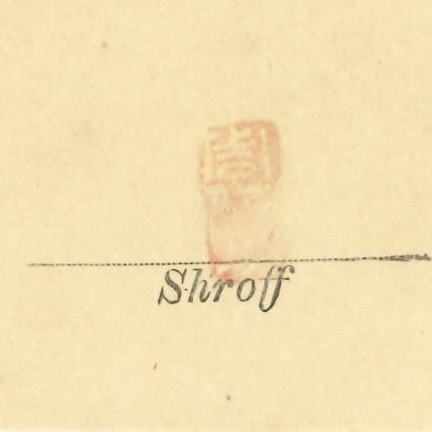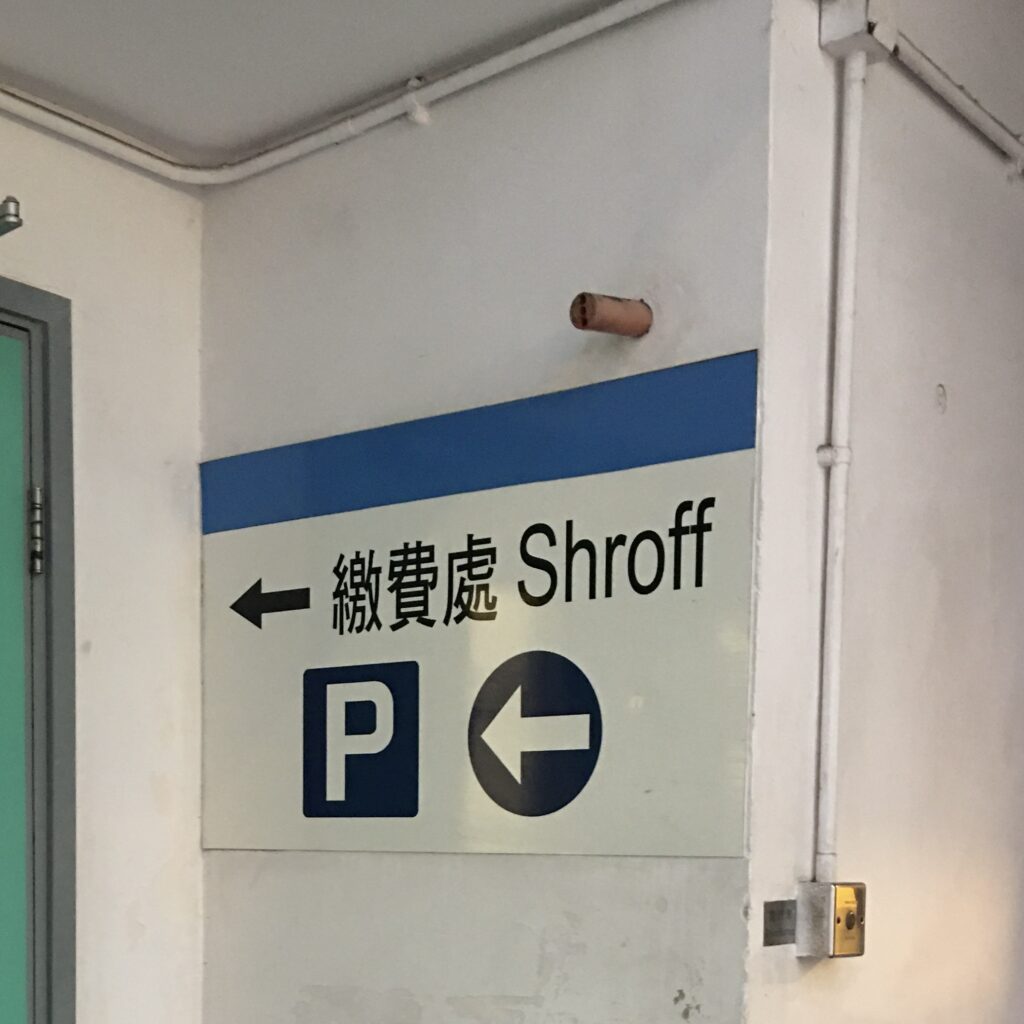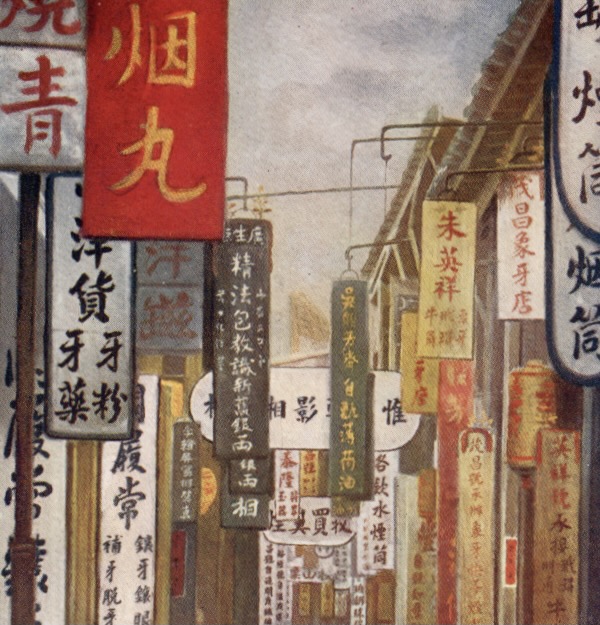Before the First Opium War (1839–1842), Westerners’ activities were confined to provincial city of Guangdong province–Canton (now Guangzhou). As described in William Hunter’s book The ‘Fan Kwae’ at Canton,the trading houses and dwellings of the Western traders usually called the “Thirteen Factories”, were located at southwestern Canton, along the Pearl River. Like today, one of the activities for Westerners to spend their leisure time was shopping. Parallel to the European factories were several commercial streets, namely China Street and and Hog Lane selling all sorts of things.1 Strolling along these streets, the first thing you would notice was myriad long and large signboards hanging outside the shops. The Chinese characters on these rectangular boards indicated the types of goods sold or services available at the shops, including ivory carvings, peppermint oil, cloisonné, smoking pipes, foreign goods, dentist, and photography. The featured postcard depicted such a scenery. One of the signboards advertised:
精zing1 ‘concise’
法faat3 ‘method’
包baau1 ‘guarantee’
教gaau3 ‘teach’
識sik1 ‘know’
新san1 ‘new’
舊gau6 ‘old’
銀ngan4 ‘sliver’
両loeng2 ‘tael’
The shop was probably what was called a “shroffing school” where students were taught the skills to detect false coins and evaluate the purity of the coins. The profession was called shroffing and the person who practised it was called a shroff. Shroffing was an ancient profession in the Indian subcontinent where a shroff was a money changer or money lender. The word shroff originates from Arabic ṣarrāf, meaning ‘a money-changer.’ It entered Hindi as śarāf and Urdu as sharāf. In Anglo-Indian English, it is spelt Sharaf and in English the usual spelling shroff (schroff is also seen). The word enters China as a result of commercial exchanges between China and the West. Before the use of paper banknotes, copper, gold, and silver were used as currency. Therefore, it was important to ensure that the coins and ingots received were of the highest quality and greatest worth. In the 19th century, besides the compradores 買maai5辦baan2, the shroffs were also essential staff in foreign firms. Well-trained shroffs could identify quickly and correctly whether a coin was genuine or counterfeit, and how much it was worth. Alfred Weatherhead, who served as a clerk of the colonial Hong Kong Government between 1855–1859, gives us an idea of the skills of shroffs:2 “the great houses and Government offices employ a class of men termed “shroffs” who calculate all matters of exchange, interests, etc. and examine all coin passing through the establishment, receiving a percentage on the amount scrutinized. The quickness and certainty with which they detect false coin is really astonishing, no matter how close the imitation be, it is almost impossible to deceive them – owing to their exquisitely delicate sense of touch, sharpened by constant practice.”2
Tong Ting-kü (also Tong King-sing), author of The Chinese and English Instructor 《英語集全》(1862), was himself a compradore so he knew exactly the qualifications and responsibilities of a shroff. The Chinese and English Instructor is a six-volume book containing vocabulary and sentences in Cantonese and English. It allows Chinese to learn English so that they could communicate effectively with the foreigners and would not be deceived.3 However, at 19-century Canton, you could also hear another type of English – pidgin Englsh or currently known as Chinese Pidgin English. This variety of English originated in Canton and functioned as a lingua franca between Chinese and Westerners. Although Tong was educated in mission school and was fluent in English, he must know that many Chinese spoken pidgin English. That’s why some sections of The Chinese and English Instructor also provided pidgin equivalents. In the book, the Chinese translation for shroff is 看hon3銀ngan2, which literally means ‘watch silver/money’. As 銀ngan2/4 ‘silver’ was an important currency during the Ming and Qing dynasties of China, the word continues to stand for money as in 銀ngan4紙zi2 ‘money, banknote’ even in the era of paper currency. The Chinese and English Instructor gives some examples of a shroff examining coins.
Shroff: this dollar no good ‘This is a bad dollar.’
Q: what for no good? ‘Why is it bad?’
After finding out that it was a copper dollar, the shroff says:
Shroff: thisee dollar no can passee ‘This dollar is not current.’
Q: what for no can passee? ‘Why is it not current?’
Shroff: China man talkee Cow chin ‘Chinese call it Cow chin.’
Cow chin in Chinese is 鈎au1錢cin4. The shroff judges that the dollar’s composition is not pure.
Shroff: this dollar hap got lead ‘This dollar is leaded’
Q: how muchee can catchee ‘What is it worth?’
Shroff: can catchee eighty cents ‘It is worth eighty cents.’
The skill of a shroff in distinguishing low-quality coin is shown in the following example. In this case, the dollar is a mixture of silver and copper.
Q: thisee dollar allee copper ‘Is this a pure copper dollar?’
Shroff: outside silver ‘The outside is silver’
inside copper ‘The inside is copper’
The exchanges are conducted in Chinese Pidgin English. Compared with English, the vocabulary of pidgin English is much reduced. Guangdong is a Cantonese-speaking province, therefore, both Cantonese and English contribute to the grammar of Chinese Pidgin English. Let’s use the above examples to show some characteristics of pidgin English. Questions and statements have different sentence structures in English, but these two types of sentences often converge structurally in Chinese Pidgin English. For instance, the question thisee dollar allee copper and the statement thisee dollar no good are structurally identical. To distinguish their functions, a commonly used strategy is to raise the intonation at the end when it is a question. The question word what for as in what for no can passee as opposed to why and what … for in English is a classic expression to ask for reasons. The other question word how muchee represents both ‘how many’ and ‘how much’. Muchee also appears in too muchee, which means ‘much, many’ before nouns and ‘very, too’ before adjectives. Chinese Pidgin English places greater emphasis on content, so function words tend to be left out. There are some instances of the omission of the copula verb be like thisee dollar no good and outside silver. The phonological systems of Cantonese and English differ in significant ways. While English allows a larger number of consonants to occur at the end of a syllable, Cantonese is more restrictive. For example, the consonants /s/, /tʃ/, and /l/, as in pass, catch, and all respectively, are not found in syllable-final position in Cantonese. Therefore, for Chinese speakers of Chinese Pidgin English adding an extra syllable such as –ee would make these words more pronounceable.


In early 20th century, many government offices in Hong Kong still retained a position called shroff as the receipt of Crown Rent of 1923 above shows. There were the signature of the treasurer and the chop of the shroff. A chop refers to a seal made of stone or rubber. However, as technology and standization of minting improved over time, the arts of shroffing became unnecessary. The duties of shroffs also changed from examining and testing coins to handling payment. Surprisingly, the word shroff survives to this day and can be seen in places like the car parks and hospitals where a shroff refers to a cashier or payment counter.
1. Hunter, William C. 1882. The ‘Fan Kwae’ at Canton Before Treaty Days 1825–1844. London: Kegan Paul, Trench, & Co.
2. Weatherhead, Alfred. Life in Hong Kong: 1856-1859. Unpublished manuscript.
3. Tong, Ting Kü (唐廷樞). 1862. The Chinese and English Instructor 《英語集全》. Canton.
